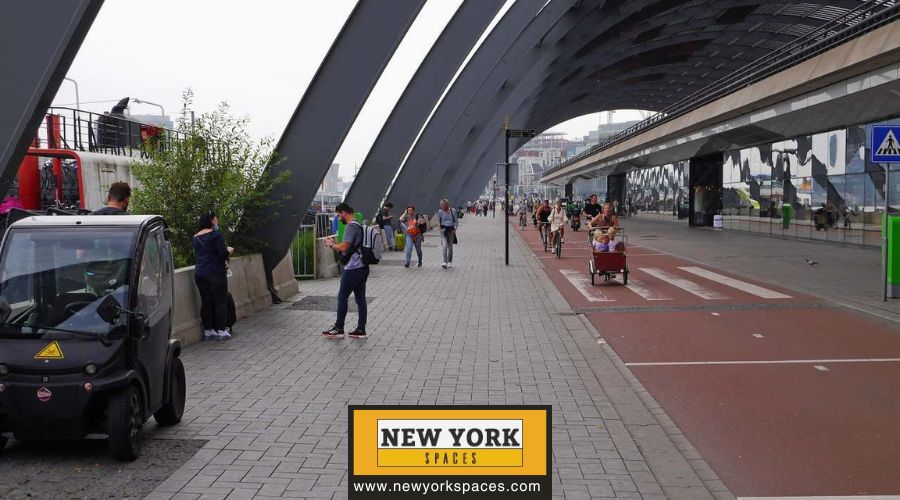Steel columns stand as silent sentinels of strength and stability in construction and architecture. These pivotal components are the backbone of modern structures, from towering skyscrapers piercing the sky to sprawling bridges spanning vast distances. Steel columns are not just about providing support; they are a testament to human ingenuity in harnessing the power of materials to build the unimaginable. This post delves into the essence of steel columns, exploring their definition, types, and critical role in construction.
The Basics of Steel Columns
Understanding steel columns begins with grasping their fundamental aspects – what they are, how they’re made, and why they’re so crucial in construction.
Definition
Steel columns are structural elements designed to transmit a compressive load. Essentially, they are the vertical supports that hold up a structure, ensuring it remains upright and stable. The primary function of steel columns is to bear the weight of the building above, distributing it to the foundation below. This role is critical in preventing the collapse of structures, making steel columns indispensable in construction projects.
Materials
The choice of steel for columns is no accident; it’s selected for its exceptional properties, which include:
Carbon Steel: The most common type used in construction, known for its high strength and flexibility. Carbon steel can withstand significant forces, making it ideal for supporting large buildings.
Stainless Steel: Valued for its resistance to corrosion and aesthetic appeal, stainless steel is often used in exposed columns where appearance matters as much as functionality.
Alloy Steels: These are used in more specialized applications, offering enhanced properties like increased strength or resistance to environmental challenges.
Each type of steel brings its unique advantages to the table, allowing engineers and architects to choose the most suitable material based on the specific requirements of their projects. The selection is influenced by factors such as the intended load-bearing capacity, environmental conditions, and the desired lifespan of the structure. This careful selection makes steel columns the sturdy pillars of modern construction.
Types of Steel Columns
The versatility of steel as a material allows for a wide range of column types, each with its specific applications and benefits. Understanding these variations is crucial for selecting the right steel column for any construction project.
- Universal Columns (UC): These are primarily used as vertical structural elements due to their larger depth than width, making them ideal for carrying axial loads. UCs are commonly found in building frameworks and are key components in the stability of structures.
- Universal Beams (UB): Unlike UCs, Universal Beams are often used horizontally as beams rather than columns. Their flanges are equal or nearly equal in size, and they are designed to carry bending moments and shear forces rather than axial loads. Their application is crucial in floors and roofs.
Understanding the distinction between UCs and UBs is fundamental in their application, ensuring that the structural elements of a building are optimized for both strength and efficiency.
Hollow Structural Sections (HSS)
Hollow Structural Sections offer a unique combination of strength and aesthetic appeal, making them a preferred choice for many architects and engineers. They come in various shapes, including:
- Circular: Used in exposed columns for aesthetic purposes and applications requiring uniform strength in all directions.
- Square and Rectangular: These are ideal for columns where a more traditional appearance is desired, offering good resistance to bending in multiple directions. Their flat surfaces also make attachment to other structural elements easier.
HSS is extensively used in structural and non-structural applications, from building frameworks to architectural features.
Other Variants
The diversity of steel columns is further expanded with the inclusion of other variants, such as:
- I-beams: Characterized by their I-shaped cross-section, these beams are used in various applications for their excellent strength-to-weight ratio.
- H-beams: Similar to I-beams but with equal thickness in the flanges and wider than I-beams, offering higher strength and used primarily in heavy construction.
- T-sections: Used where a load-bearing capacity is needed along one axis. They resemble the letter “T” and are often used with other structural elements.
Each steel column type has unique properties and applications, allowing for customized solutions in construction projects.
Design and Manufacturing
The process of creating steel columns is intricate, combining technical expertise with precision engineering to produce elements that meet the rigorous demands of modern construction.
Fabrication Process
The fabrication of steel columns involves several key steps:
- Cutting: Steel is cut to the required lengths using flame, sawing, or plasma cutting methods.
- Shaping: The steel is then shaped into the desired form, whether it be I-beams, HSS, or other profiles, through processes such as rolling and bending.
- Assembling: Components, often welding or bolting, are assembled to create the final column structure.
This process allows for the customization of steel columns to meet specific project requirements, ensuring that each piece contributes optimally to the structure’s integrity.
Design Considerations
The design of steel columns is influenced by many factors, ensuring they can withstand their demands. Key considerations include:
Load Capacity: Determining the maximum load the column can support without risk of failure.
Height: The taller the column, the more susceptible it is to buckling under load, requiring careful design to prevent instability.
Environmental Factors: Considerations such as exposure to corrosive elements or the need for fire resistance influence material selection and design specifications.
By taking into account these and other factors, engineers can design steel columns that not only support the physical loads of the structure but also withstand the environmental challenges they will face over their lifetime.
Installation and Application
Installing steel columns is a critical phase in construction, requiring precision and expertise to ensure the safety and integrity of the structure.
Installation Process
The installation of steel columns typically involves the following steps:
- Preparation: Site preparation includes setting out the location for each column according to the construction plans.
- Positioning: The steel columns are transported to the site and positioned using cranes or other lifting equipment.
- Alignment: Once in position, the columns are aligned vertically using levels and plumb lines to ensure they are perfectly upright.
- Securing: The columns are then secured to the foundation or the structure below using bolts or welding, providing a stable base for the construction above.
This process is crucial for the overall success of the construction project, ensuring that the structure will be safe and stable for its intended lifespan.
Application Examples
Steel columns are used in various structures, showcasing their versatility and strength. Some notable examples include:
- Skyscrapers: Their strength allows them to support the immense weight of tall buildings.
- Bridges: Steel columns are used to construct bridges, offering support for spans and loads.
- Industrial Buildings: Factories and warehouses often use steel columns for their large open spaces and heavy-duty requirements.
- Residential Construction: Steel columns can be found in residential buildings, supporting floors and roofs.
These examples highlight the adaptability of steel columns to various architectural and structural demands, making them a staple in construction.
Advantages of Using Steel Columns
Using steel columns in construction projects brings several significant benefits, from durability to design flexibility.
Strength and Durability
- Superior Strength: Steel’s high strength-to-weight ratio makes it capable of supporting large loads, making it ideal for use in columns.
- Longevity: Steel is resistant to many of the common issues that affect other materials, such as rot, pests, and fire, contributing to a longer lifespan for structures.
Flexibility in Design
- Architectural Freedom: The versatility of steel allows for innovative designs and complex shapes, enabling architects to push the boundaries of creativity.
- Adaptability: Steel can be easily modified and strengthened, accommodating future structural changes or expansions.
Cost-Effectiveness
- Efficiency: Steel’s durability and minimal maintenance requirements lower long-term costs.
- Speed of Construction: Steel columns can be prefabricated and quickly assembled on-site, speeding up the construction process and reducing labor costs.
These advantages make steel columns a preferred choice in construction, offering a blend of strength, flexibility, and cost-efficiency that is hard to match with other materials.
Maintenance and Sustainability
Maintaining steel columns ensures their longevity and structural integrity, while their role in sustainable construction highlights the material’s environmental benefits.
Maintenance Requirements
Regular maintenance is essential to maximize the lifespan of steel columns and prevent potential issues:
Inspection: Routine inspections can identify signs of corrosion or damage early, allowing for timely interventions.
Painting and Coatings: Applying protective coatings or paint can shield steel from moisture and chemicals, significantly reducing the risk of corrosion.
Cleaning: Regular cleaning to remove debris and contaminants can also help prevent corrosion and other damage.
These maintenance practices ensure that steel columns remain in good condition, supporting the structure effectively for many years.
Sustainability
Steel’s contribution to sustainable construction is significant, thanks to its recyclability and durability:
Recyclability: Steel is one of the most recycled materials in the world, which means steel columns can be melted down and reused without losing quality.
Energy Efficiency: The durability and strength of steel reduce the need for replacements, while its adaptability allows for more energy-efficient building designs.
Resource Conservation: Using recycled steel for columns reduces the demand for raw materials, contributing to environmental conservation.
Steel columns support physical structures and promote sustainability in the construction industry.
Challenges and Solutions
Steel columns face challenges like corrosion and fire vulnerability despite their many benefits, prompting innovative solutions and technological advancements.
Corrosion Resistance
Challenge: Steel is prone to corrosion when exposed to moisture and oxygen, potentially compromising its structural integrity.
Solutions:
- Coatings: Protective coatings, such as galvanization or epoxy paints, shield steel from corrosive elements.
- Cathodic Protection: This method involves applying a small, direct current to the steel, counteracting the electrochemical process of corrosion.
Fire Resistance
Challenge: Steel loses strength at high temperatures, which can be a significant risk in a fire.
Solutions:
- Fireproofing: Applying fire-resistant materials to steel columns can significantly increase fire resistance.
- Innovative Materials: Developing steel alloys with improved fire resistance and intumescent paints that expand in the heat to form a protective barrier.
Technological Advancements
- Improved Fabrication Techniques: Advances in manufacturing have resulted in steel columns with better properties and performance.
- Smart Monitoring Systems: Integrating sensors and IoT technology for real-time monitoring of structural health, allowing for proactive maintenance and ensuring the longevity of steel structures.
These solutions and advancements have significantly enhanced the performance and safety of steel columns, ensuring they remain a vital component of modern construction.
Conclusion
Steel columns are indispensable to the construction and architectural landscapes, offering unmatched strength, durability, and flexibility, making them a cornerstone of modern infrastructure. They support and shape our built environment, from skyscrapers and bridges to residential buildings. Despite facing challenges like corrosion and fire vulnerability, ongoing materials science and engineering advancements have continuously improved their performance and safety.
Furthermore, their maintenance requirements and contribution to sustainability through recyclability and energy efficiency underscore steel columns’ essential role in today’s construction projects and pave the way for future innovations. As we look forward, the continued evolution and application of steel columns promise to expand the possibilities of architectural design and construction technology, reinforcing their status as a fundamental component of structural engineering.


